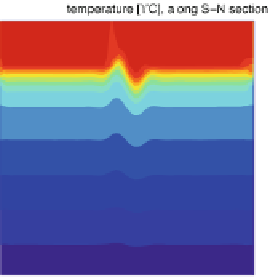Civil Engineering Reference
In-Depth Information
a
b
Fig. 5.33 Stratification of temperature along the
y
-section from S to N through the OWF for (a)
F01-METRAS approach and (b) F04-Brostr¨m approach. The Brostr¨m approach leads to a more
significant effect at the upper layer with slightly stronger excursion at the thermocline
The more intense warming in F04 is related to a continuous downwelling cell
from surface to bottom with continuous high vertical velocities within the OWF
than in case F01. Continuous vertical velocity cells support temperature advection
over the entire ocean depth, which explains stronger changes at the thermocline.
Figure
5.33
illustrates the impact of run F01 and run F04 on the excursion of the
thermocline. Finally, the Brostr¨m approach leads to a more significant effect at the
upper layers with a slightly stronger excursion at the thermocline than the
METRAS approach. At depths below 40 m, the excursion is stronger by F04;
hence, F04 fortifies the OWF effect over the vertical layers. Due to this analysis,
it can be assumed that a stronger effect on surface elevation forwards temperature
changes in the vertical. Hence, the Brostr¨m approach helps to identify the impact
of an OWF on the ocean but tends to an overestimation of the OWF effect,
especially for temperature changes.
Upshot
The Brostr¨m approach (F04) was defined for theoretical analysis of wind farm
effects on the ocean surface having a quadrate, cubic arrangement. Nevertheless, as
mentioned, here the produced OWF wind wake is too small, compared to the
METRAS approach (F01) and satellite data. However, the Brostr¨m approach is
considered here to elucidate that, especially, the wind wake plays an important role
due to physical reasons given in Sect.
4.2.2
and triggers the ocean system. The
flanks of the wind wake, being simulated by METRAS, have a secondary role on
the ocean
s reaction and mainly support an upwelling zone. Anyhow, the use of the
Brostr
¨
m approach is restricted and not as realistic as the use of the METRAS
advantage where turbine specifications are considered and OWF formation is
arbitrary, which ends in a more realistic wind field and therefore into a more
realistic change in surface elevation. Thus, the Brostr¨m approach cannot be
'









































































































































































































































































Search WWH ::

Custom Search